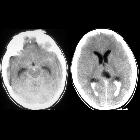cerebral oedema
Cerebral edema refers to a number of interconnected processes which result in abnormal shifts of water in various compartments of the brain parenchyma.
It has traditionally been broadly divided into vasogenic cerebral edema and cytotoxic cerebral edema, the latter a term commonly used to denote both true cytotoxic edema and ionic edema . In addition, although traditionally not included in discussions on edema, hemorrhagic transformation can be thought of as an extreme end-stage form of the same processes which lead to edema.
As such a more precise classification is :
Special types of edema to be considered:
- transependymal edema (also known as interstitial cerebral edema)
- combined cerebral edema
Siehe auch:
- Hirnabszess
- Pseudosubarachnoidalblutung
- Hirntumoren
- Einklemmung Foramen magnum
- Bluthirnschranke
- causes of unilateral cerebral edema
- Höhenhirnödem
und weiter:
 Assoziationen und Differentialdiagnosen zu Hirnödem:
Assoziationen und Differentialdiagnosen zu Hirnödem:


















